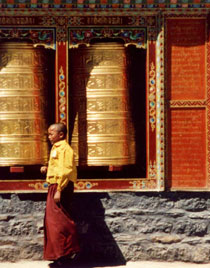History of Sakya Monastery
There are two ways to inherit power: its religious power is descended from paternal uncle to nephew while its political authority from father to son. After Gongquejiemian passed away, his son Gongeningpu (1092-1158), who was very wisdom and also perfected the Sakya Sect, took charge of the Sakya Monstery. Gongeningpu was also reputed as “Saqin”(Sakya Master), the founder of this sect. The second son of Gongeningpu, Suonanfangmo became the second Sakya Throne Holder. The third son Zhabajianzan who had ruled the monastery for 57 year became the third Throne Holder. The first son of Gongquejiemian’s fourth son, Beiqinwopu, Sapangongejianzan(1182-1251), shorted for Sapan or Sakyapan Master, also a famous character in Sakya Sect, became the fourth Throne Holder.
At the beginning of 13 century AD the Mongolia tribe with its leader Genghis khan sprung up and unified Central China by force. In 1240 General Kuotuan in Yuan Dynasty wanted to call in Sanpangongejianzan who enjoyed high reputation among Tibetan sects before advancing to Tibet. In 1244 the nephew of Sanpangongejianzan, Basipa(1235-1280) went to Liangzhou(now Wuwei,Gansu) to meet Kuotuan in 1247 and wrote to Hierarchs and nobles in every Tibetan sect  persuading them to accept the Yuan Dynasty’s condition, and then Tibet was brought into Chinese domain officially. After Kublai khan unified the whole China and founded Yuan Dynasty central government, he assigned Basipa as “Emperor’s Master” and obliged “assign to rule all the Buddhism Sect ”jade seal, which meant that he managed the national Buddhism affairs and assisted central government to rule 130,000 families in Tibet. Basipa took Kublai khan’ s order. He checked registered permanent residence and legislated law. In 1268 Sakya set up a local regime in the same structure as the other provinces in China. And Basipa was assigned as the Administration Officer of Tibet subjected to Central Government. Sakya Sect reached at the height of power and splendor. In the late 14th century, along with the perdition of Yuan Dynasty, Geju sect replaced the power of Sakya, but it still survived.
persuading them to accept the Yuan Dynasty’s condition, and then Tibet was brought into Chinese domain officially. After Kublai khan unified the whole China and founded Yuan Dynasty central government, he assigned Basipa as “Emperor’s Master” and obliged “assign to rule all the Buddhism Sect ”jade seal, which meant that he managed the national Buddhism affairs and assisted central government to rule 130,000 families in Tibet. Basipa took Kublai khan’ s order. He checked registered permanent residence and legislated law. In 1268 Sakya set up a local regime in the same structure as the other provinces in China. And Basipa was assigned as the Administration Officer of Tibet subjected to Central Government. Sakya Sect reached at the height of power and splendor. In the late 14th century, along with the perdition of Yuan Dynasty, Geju sect replaced the power of Sakya, but it still survived.
Sakya sect doesn’t forbid marriage, taking Taoguo as its main sutra. It plays an important role in the development of Tibetan culture. During its rule, Tibet ended the war situation lasting 400 years, thus the society developed and the culture and art became prosperous. At that time, some hierarchs of Sakya sect had lots of translation works on literature and history , such Sakya Proverb by Sapan, Zhangruzhilun by Basipa. The character created by Basipa under Kublai khan’s order, called Basipa Character, enjoyed an important position in Chinese character history.